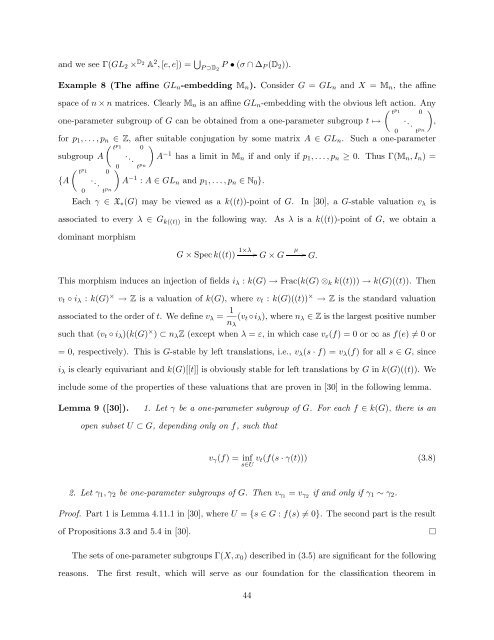Equivariant Embeddings of Algebraic Groups
Equivariant Embeddings of Algebraic Groups
Equivariant Embeddings of Algebraic Groups
You also want an ePaper? Increase the reach of your titles
YUMPU automatically turns print PDFs into web optimized ePapers that Google loves.
and we see Γ(GL 2 × D 2<br />
A 2 , [e, e]) = ⋃ P ⊃D 2<br />
P • (σ ∩ ∆ P (D 2 )).<br />
Example 8 (The affine GL n -embedding M n ). Consider G = GL n and X = M n , the affine<br />
space <strong>of</strong> n × n matrices. Clearly M n is an affine GL n -embedding with the obvious left action. Any<br />
( t p 1 0<br />
one-parameter subgroup <strong>of</strong> G can be obtained from a one-parameter subgroup t ↦→ . .. ,<br />
0 t pn )<br />
for p 1 , . . . , p n ∈ Z, after suitable conjugation by some matrix A ∈ GL n . Such a one-parameter<br />
( t p 1 0<br />
)<br />
subgroup A . .. A −1 has a limit in M n if and only if p 1 , . . . , p n ≥ 0. Thus Γ(M n , I n ) =<br />
( 0 t pn<br />
t p 1 0<br />
{A . .. A −1 : A ∈ GL n and p 1 , . . . , p n ∈ N 0 }.<br />
0 t pn )<br />
Each γ ∈ X ∗ (G) may be viewed as a k((t))-point <strong>of</strong> G.<br />
In [30], a G-stable valuation v λ is<br />
associated to every λ ∈ G k((t)) in the following way.<br />
As λ is a k((t))-point <strong>of</strong> G, we obtain a<br />
dominant morphism<br />
G × Spec k((t)) 1×λ G × G µ G.<br />
This morphism induces an injection <strong>of</strong> fields i λ : k(G) → Frac(k(G) ⊗ k k((t))) → k(G)((t)). Then<br />
v t ◦ i λ : k(G) × → Z is a valuation <strong>of</strong> k(G), where v t : k(G)((t)) × → Z is the standard valuation<br />
associated to the order <strong>of</strong> t. We define v λ = 1 (v t ◦i λ ), where n λ ∈ Z is the largest positive number<br />
n λ<br />
such that (v t ◦ i λ )(k(G) × ) ⊂ n λ Z (except when λ = ε, in which case v ε (f) = 0 or ∞ as f(e) ≠ 0 or<br />
= 0, respectively). This is G-stable by left translations, i.e., v λ (s · f) = v λ (f) for all s ∈ G, since<br />
i λ is clearly equivariant and k(G)[[t]] is obviously stable for left translations by G in k(G)((t)). We<br />
include some <strong>of</strong> the properties <strong>of</strong> these valuations that are proven in [30] in the following lemma.<br />
Lemma 9 ([30]).<br />
1. Let γ be a one-parameter subgroup <strong>of</strong> G. For each f ∈ k(G), there is an<br />
open subset U ⊂ G, depending only on f, such that<br />
v γ (f) = inf<br />
s∈U v t(f(s · γ(t))) (3.8)<br />
2. Let γ 1 , γ 2 be one-parameter subgroups <strong>of</strong> G. Then v γ1 = v γ2 if and only if γ 1 ∼ γ 2 .<br />
Pro<strong>of</strong>. Part 1 is Lemma 4.11.1 in [30], where U = {s ∈ G : f(s) ≠ 0}. The second part is the result<br />
<strong>of</strong> Propositions 3.3 and 5.4 in [30].<br />
The sets <strong>of</strong> one-parameter subgroups Γ(X, x 0 ) described in (3.5) are significant for the following<br />
reasons.<br />
The first result, which will serve as our foundation for the classification theorem in<br />
44
















